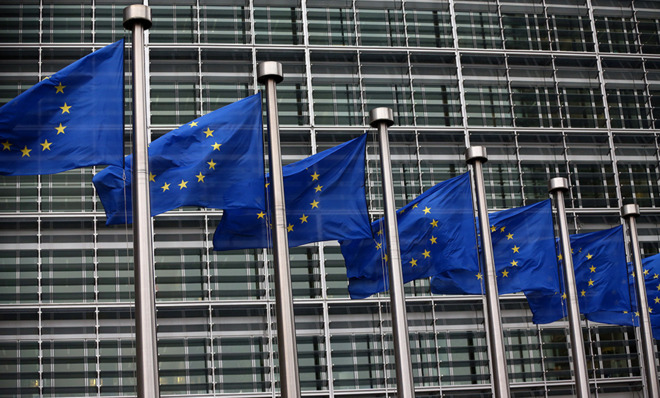Is the EU's new infrastructure plan a New Deal for the 21st century?
European policy-makers are relying heavily on public-private partnerships for investment. It may not be enough.


There's a saying: Everybody wants to be a bodybuilder, but nobody wants to lift any weights.
That maxim came to mind last week, as incoming European Commission President Jean-Claude Juncker announced the details of Europe's latest infrastructure initiative, the European Fund for Strategic Investments (EFSI).
To an observer in the United States, the €315 billion plan sounds enviable — a New Deal for Europe. Beneath the surface, though, the new initiative is hardly a bold move toward greater public investment.
The Week
Escape your echo chamber. Get the facts behind the news, plus analysis from multiple perspectives.

Sign up for The Week's Free Newsletters
From our morning news briefing to a weekly Good News Newsletter, get the best of The Week delivered directly to your inbox.
From our morning news briefing to a weekly Good News Newsletter, get the best of The Week delivered directly to your inbox.
In fact, the Juncker plan falls victim to the same problem that has plagued infrastructure policy here in the U.S.: too little public money, and too much faith in the private sector.
A bridge too far
That's not to say private infrastructure investment is necessarily a problem (it isn't), or that EFSI won't attract private money (it will).
But it means that for all of the new program's good intentions, it may prove useless in helping build projects that are very necessary for Europe, yet aren't necessarily profitable.
A free daily email with the biggest news stories of the day – and the best features from TheWeek.com
That's because EFSI relies on a very small pot of government money to attract a very large amount of private-sector investment, mostly through infrastructure projects known as "public-private partnerships."
The EU is slated to contribute only €16 billion to EFSI at first, and none of this is actually new spending.
Instead, the funds will be redirected from other programs and taken from the EU's "budget margin," the government equivalent of the loose change you find under your sofa cushion. Those funds — along with €5 billion that the European Investment Bank will chip in — will leverage about €15 from outside investors for every government euro spent, EU officials say, resulting in €315 billion overall.
This design is EFSI's greatest political strength, but also its greatest practical weakness.
Given its heavy reliance on private-sector involvement, EFSI may ultimately function better as a financial tool than as a social one. That is, rather than proactively prioritizing construction of the continent's most vital infrastructure projects, it may instead merely lend money on a first-come, first-served basis to public-private partnerships that would have happened anyway.
The problem of the pipeline
It's an issue that infrastructure experts on both sides of the Atlantic know all too well.
In 1998, the Transportation Infrastructure Finance and Innovation Act created a smaller but similar program in the U.S., with the high-minded goal of financing "projects of national significance."
Since then, however, the program has been modified to approve projects based almost solely on their ability to pay back the government's money, rather than the extent to which they'll benefit the public.
Meanwhile, a previous EU program, the Loan Guarantee Instrument for Trans-European Transport Network Projects, met with moderate success, but faced problems finding enough worthwhile projects to underwrite.
An official evaluation of the initiative urged that, in the future, "the initial focus should be on stimulating the pipeline of projects," and noted that the program "does not have the power to make projects by virtue of its existence."
The European Commission seems well aware that EFSI may fall victim to this problem. But its solution is meek at best: an "Investment Task Force" that will try to convince the private sector of the merits of particular projects. Such investors, the report optimistically claims, may be "unaware of the potential of these projects...given their intrinsically complex nature."
Unfortunately, U.S. policy-makers also seem to believe that cajoling bankers is all it will take to open up the infrastructure "pipeline." At a September infrastructure conference hosted by the U.S. Treasury Department, among the topics discussed was "Generating a pipeline: convincing investors that the public-private partnership market is robust."
The heavy lifting
To many observers, this private-sector hesitance has emerged as the key problem with infrastructure investment. But such hesitance actually makes a lot of sense, and it doesn't take an economist to see why.
After all, neither EFSI nor any other program will ever be able to convince banks to invest in a piece of infrastructure that won't turn a profit. And that's a severe problem, since our most important pieces of infrastructure are often unprofitable, even when they benefit the broader economy.
These projects require a much greater public stake, since governments can rely on their taxing power to fund infrastructure that is broadly beneficial. But with many politicians on both sides of the Atlantic still marching to the drumbeat of austerity, neither Juncker nor his U.S. counterparts are in a position to embrace this reality.
French policy-makers, to their credit, sought a much larger EU contribution to the new fund — as much as €80 billion, according to The Financial Times. But their proposal died due to pressure from Northern European fiscal hawks, who demanded that EFSI not increase the overall size of the EU's budget.
In the U.S., meanwhile, President Obama has so far refused to support an increase in the gas tax, the main method the federal government uses to fund infrastructure projects stateside.
EFSI may prove a useful financing tool. But at the end of the day, it is only a tool of opportunity, one that will never replace the most basic methods of public infrastructure funding.
Without a doubt, that funding is a heavy weight for governments to bear, both in Europe and the U.S. But the private sector, for all its strength, has shown that it often won't step into the gym. It's time government started lifting again.
Jacob Anbinder is a policy associate at the Century Foundation, the New York-based think tank. He writes about transportation, infrastructure, and urban affairs.
-
 How weight-loss jabs are changing the way we eat
How weight-loss jabs are changing the way we eatIn The Spotlight Anti-obesity drugs have been a boon for Babybel but are supermarkets ready for a slimmed-down Christmas?
-
 Sudoku hard: December 18, 2025
Sudoku hard: December 18, 2025The daily hard sudoku puzzle from The Week
-
 Crossword: December 18, 2025
Crossword: December 18, 2025The daily crossword from The Week
